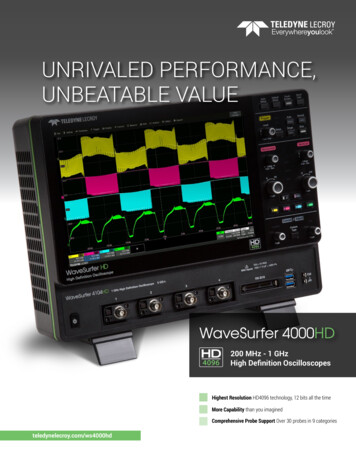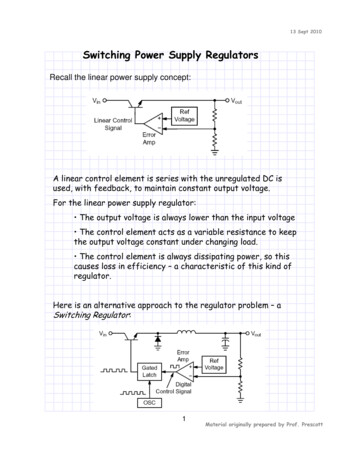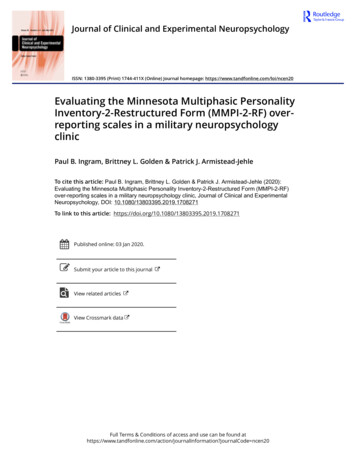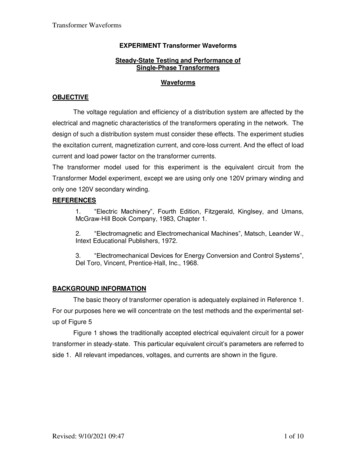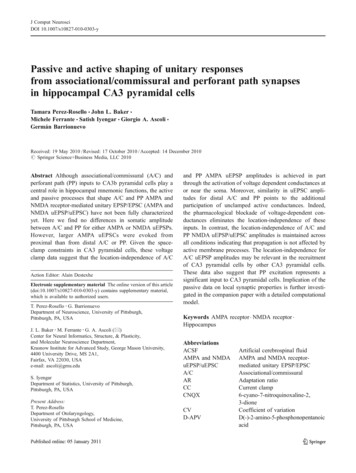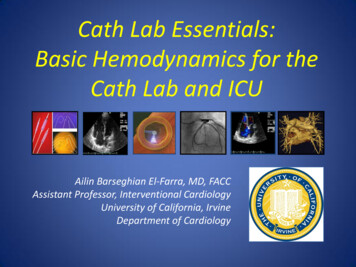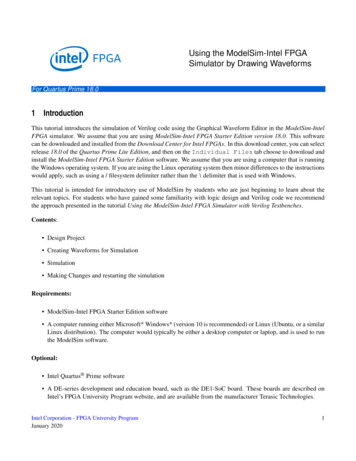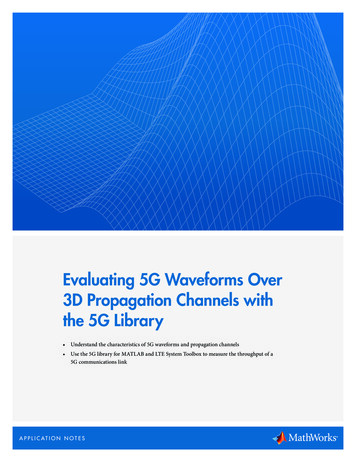
Transcription
Evaluating 5G Waveforms Over3D Propagation Channels withthe 5G Library Understand the characteristics of 5G waveforms and propagation channels Use the 5G library for MATLAB and LTE System Toolbox to measure the throughput of a5G communications linkA P P L I C AT I O N N O T E S
Evaluating 5G Waveforms Over 3D Propagation Channels with the 5G Library5G StandardizationThe 3GPP standardization group is responsible for defining the wireless 5G standard, and is undertaking this task with help from many participants and contributions from around the globe. Release15 of the 3GPP standard, expected by September 2018, will introduce the 5G standard. One output ofthe standardization group will be specifications of the physical layer and scenarios for 5G extrememobile broadband (eMBB).The 3GPP standard body has already agreed on a number of points [1] including: Several types of waveforms: cyclic-prefix OFDM and SC-FDMA (the ones used in LTE), with filtered-OFDM and windowed OFDM under consideration as additional options for spectralconfinement Two types of propagation channels for simulations with frequencies in the 500 MHz to 100 GHzrange, defined in documents TR 38.900: Tapped Delay Line (TDL) and Clustered Delay Line(CDL) Variable inter-carrier spacing and, accordingly, variable length of OFDM symbols (although someof the details such as the exact subframe structure are still being finalized) Several coding schemes including LDPC for data channels and polar codes for control channelsThe 5G library, for use with MATLAB , LTE System Toolbox , and Communications SystemToolbox , keeps you on the forefront of the standardization effort by offering an executable version offeatures already defined or under consideration, such as propagation channels and 5G waveforms. Itprovides functions and link-level reference designs that let you explore behavior and performance of3GPP new radio (NR) technologies. Alongside LTE System Toolbox and Communications SystemToolbox, the 5G library offers major parts of the 5G physical layer functionality including coding anddecoding schemes.This application note summarizes a few characteristics of 5G waveforms as well as propagation channels, and describes how to use the 5G library capabilities to measure the throughput of a completeclosed-loop 5G communications link.5G WaveformsFour waveforms are defined or considered for 5G, all of which are based on orthogonal frequencydivision multiplexing (OFDM): ([2], [3], [4]) Traditional cyclic-prefix OFDM (CP-OFDM) Traditional single-carrier frequency division multiple access (SC-FDMA) Windowed OFDM (W-OFDM; also known as weighted overlap and add or WOLA-OFDM) Filtered OFDM (F-OFDM)A P P L I C AT I O N N O T E S 2
Evaluating 5G Waveforms Over 3D Propagation Channels with the 5G LibraryThis application note does not discuss SC-FDMA, as it is well understood to be a scheme suitable foruplink with reduced peak to average power ratio (PAPR). Note that, in addition to SC-FDMA, OFDMis now also selected for the uplink.CP-OFDM is the modulation scheme used in LTE. While offering perfect inter-symbol (ISI) andinter-carrier interference (ICI) protection (with ideal synchronization), CP-OFDM suffers from poorout of band emission (OOBE) characteristics. Alternative modulation schemes such as F-OFDM andW-OFDM specify additional processing that trade-off OOBE reduction versus complexity, delay, andICI/ISI protection. These schemes also promise to increase the spectral efficiency beyond the 90%limit that was chosen for LTE.F-OFDMIn this scheme, the signal generated after inverse IFFT for a number of resource blocks (RBs), is filtered with a passband filter that has: Sharp transition Flat characteristics in the passband High out-of-band rejectionThe design considered is a perfect lowpass weighted by a Hanning window. It is known that the frequency response of a truncated sinc function (truncated ideal lowpass) exhibits some ripple aroundthe band edges. Therefore, the bandwidth of the perfect lowpass can be extended on both sides(shown in red in Figure 1) by a small amount, called tone offset. This ensures the ripple is locatedoutside of the desired passband.The filter is hence characterized by two primary parameters:Filter LengthLength of the filterTone OffsetNumber of additional subcarriers to include in the passband when designingthe filterFigure 1 shows the frequency response of the F-OFDM filter for a 100 RB signal with filter length 513and two values of tone offset: 0 and 12 subcarriers.A P P L I C AT I O N N O T E S 3
Evaluating 5G Waveforms Over 3D Propagation Channels with the 5G LibraryFigure 1. Frequency response of the F-OFDM filter.Figure 2 shows a detail of the edge of the passband. We can observe that the higher ripple is pushedout of the signal passband when tone offset is set to 12.Figure 2. Frequency response of the F-OFDM filter around the edge of the passband.A P P L I C AT I O N N O T E S 4
Evaluating 5G Waveforms Over 3D Propagation Channels with the 5G LibraryUsing the 5G library you can explore and quantify the effects of these parameter on the out of bandemissions.W-OFDMIn W-OFDM, processing is performed at the beginning and end of each OFDM symbol after IFFTcomputation. A cyclic prefix (CP) and cyclic suffix (CS) are added to the computed OFDM symbol,and (raised-cosine) windowing is performed such that the window amplitude is -3dB at the beginningand end of the OFDM symbol. This allows for perfect reconstruction of the OFDM symbol whenadding the CS to the beginning and the CP to the end.Figure 3 shows the raised cosine window for this configuration: the amplitude of the first and lastsamples OFDM symbol (in blue) is affected by the window for a total length corresponding to theprefix and suffix lengths.Figure 3. OFDM symbol with additional cyclic prefix and suffix.Note that, contrarily to CP-OFDM, where the cyclic prefix is typically discarded, W-OFDM relies oncombining the CS and CP back with the original OFDM symbol in order to reconstruct a full OFDMsymbol (in blue) with constant amplitude of 1.The window is characterized by one primary parameter:Roll-off factor for the window. The lengths n1 and n2 of the CP and CS respectively are derived from Alpha as follows:n1 fix(alpha*(nfft/2)) - 1;Alphan2 n1 1;where nfft is the FFT length and fix rounds towards 0A P P L I C AT I O N N O T E S 5
Evaluating 5G Waveforms Over 3D Propagation Channels with the 5G LibraryIn addition, the 5G library gives the option to replace the default window with an arbitrary windowfor further exploration:WindowCoeffsWindowing function samples to replace the (default) raised cosinewindowWaveform CharacterizationThe 5G library lets you characterize the OOBE and performance of each one of the waveforms. The“hNewRadio5GWaveforms” example analyzes the spectral characteristics, EVM, and emission performance of all three waveforms.Due to the better OOBE of F-OFDM and W-OFDM, the bandwidth occupancy ratio of the signal, formerly limited to 90% (i.e., 100 RBs on a 20MHz signal), can be slightly increased.In the hNewRadio5GWaveforms example, we compare the spectral characteristics of CP-OFDM over100 RBs with W-OFDM and F-OFDM over 108 RBs.Some of the code used to create the signal is shown below:[ ]genb lteRMCDL(rmc);switch(genb.WaveformType)case ‘W-OFDM’genb.Alpha 0.11;case ‘F-OFDM’genb.FilterLength 513;genb.ToneOffset 2.5;end% Generate resource griddata [1; 0; 0; 1];[ ,txgrid] lteRMCDLTool(genb,data);% OFDM modulation (W-OFDM, F-OFDM, CP-OFDM)[txwaveform,txinfo] h5gOFDMModulate(genb,txgrid);[ ]A P P L I C AT I O N N O T E S 6
Evaluating 5G Waveforms Over 3D Propagation Channels with the 5G LibraryThe lteRMCDL and lteRMCDLTool functions are part of LTE System Toolbox. We can easily generate an LTE-compliant grid with those functions (the txgrid output of lteRMCDLTool). Theh5gOFDMModulate function performs 5G modulation of the generated grid according to the 5Gwaveform selected: CP-OFDM, W-OFDM, or F-OFDM.The parameters for W-OFDM and F-OFDM were chosen as fset2.5Figure 4 shows the spectrum of the CP-OFDM, W-OFDM and F-OFDM signals around the passbandedge.Figure 4. Spectrum of CP-OFDM (100RBs), W-OFDM (108RBs), and F-OFDM (108RBs).As expected, both W-OFDM and F-OFDM exhibit a more rapid drop-off in power outside of theuseful band. There are a few more observations that can be made: CP-OFDM decay is very slow F-OFDM has a steeper drop-off than W-OFDMA P P L I C AT I O N N O T E S 7
Evaluating 5G Waveforms Over 3D Propagation Channels with the 5G LibraryMeasurements confirm these observations: The energy measured for all CP-OFDM, W-OFDM, andF-OFDM in the 5MHz band next to the passband is -66.5dBm, -92.2dBm, and -130.6dBm respectively. The EVM measurement for CP-OFDM, on the other hand, is almost 0.However, a few more elements have to be taken into account before drawing a definite conclusion.Let’s start with CP-OFDM. First we admit that comparison with unfiltered CP-OFDM is unfair.Out of the box, unfiltered CP-OFDM does not meet ACLR requirements for LTE. Meeting ACLRrequirements involve some sort of filtering, and therefore, the hNewRadio5GWaveforms exampleshipped with the 5G library includes a low-pass filter, which meets ACLR requirements and slightlydegrades EVM.Figure 5 shows the revised spectrum comparison.Figure 5. Spectrum of CP-OFDM with ACLR filtering, W-OFDM (108RBs), and F-OFDM (108RBs).At this point, the performance of W-OFDM appears to be significantly inferior to F-OFDM orCP-OFDM modified for ACLR. It must be noted that W-OFDM requires fewer computations thanF-OFDM.A P P L I C AT I O N N O T E S 8
Evaluating 5G Waveforms Over 3D Propagation Channels with the 5G LibraryOne final point worth considering, though, is how real-world implementation with less than perfectamplifiers may impact performance for those schemes. The hNewRadio5GWaveforms example alsoprovides analysis of the impact of non-linear amplification. We use Communications System Toolboxto model non-linearities introduced by typical power amplifiers.Here are the relevant lines:% Apply PA non-linear clippingif (clipping)nonLinearity comm.MemorylessNonlinearity;nonLinearity.Method ‘Rapp model’;nonLinearity.LinearGain -6;nonLinearity.Smoothness 0.8;oversampled nonLinearity(oversampled);endFigure 6 shows the revised spectrum plot with a non-linear amplifier using a Rapp model.Figure 6. Spectrum of CP-OFDM, W-OFDM (108RBs), and F-OFDM (108RBs) with non-linear amplifier.A P P L I C AT I O N N O T E S 9
Evaluating 5G Waveforms Over 3D Propagation Channels with the 5G LibraryWhen non-linear amplification is taken into account, the inherent performance advantage ofF-OFDM over W-OFDM is less straightforward. Which scheme is most appropriate will depend onthe exact parameters as well as the RF implementation and compensation schemes such as digital predistortion (DPD).Channel ModelsThe 3GPP technical report TR 38.900 [5] defines two types of channel models for link-level evaluations in the 500 MHz to 100 GHz range: Tapped Delay Line (TDL) Clustered Delay Line (CDL)Those channels support a signal bandwidth of up to 2GHz.TR 38.900 defines five typical profiles for each channel: CDL/TDL-A, CDL/TDL -B, and CDL/TDL -C are non-line-of-sight (NLOS) CDL/TDL-D and CDL/TDL-E are line-of-sight (LOS)Each CDL profile includes direction of departure and arrival in azimuth and elevation, as well as anangular spread for each of those characteristics: CDL is a 3D channel.A key difference with previous LTE models, such as ETU and EVA, is that each profile only definesnormalized tap delays. Tap delays can then be scaled (linearly) to achieve the desired delay spread. TR38.900 suggests that delay spreads can range from 10ns (very short delay spread) to 1000ns (very longdelay spread), with 100ns representing a “nominal delay spread.”The TDL models are obtained from the corresponding CDL models assuming isotropic antennas, butTR 38.900 also makes provisions for non-isotropic antennas.Furthermore, in order to better support MIMO processing, TR 38.900 also defines the possibility toscale and translate angles and angle spreads. Finally, the K-factor for LOS models can also bemodified.The 5G library implements TR 38.900 CDL and TDL channel models including all specified profiles,scaling of delays, scaling of angles, and modification of the K factor for LOS channel model.A P P L I C AT I O N N O T E S 10
Evaluating 5G Waveforms Over 3D Propagation Channels with the 5G LibraryTable 1 provides a list of relevant functions for propagation channel modeling including TR 38.900channels.Function nameDescriptionLocationnr5gCDLChannelTR 38.900 CDL channel model5G Librarynr5gTDLChannelTR 38.900 TDL channel model5G LibrarylteFadingChannelMultipath fading MIMO channel propagation conditionsLTE System ToolboxlteMovingChannelMoving channel propagationconditionsLTE System ToolboxlteHSTChannelHigh-speed train MIMO channel propagation conditionsLTE System Toolboxcomm.MIMOChannelFilter input signal throughMIMO multipath fadingchannelCommunications SystemToolboxfsplFree space path lossPhased Array System ToolboxfogplRF signal attenuation due tofog and cloudsPhased Array System ToolboxrainplRF signal attenuation due torainfallPhased Array System ToolboxgasplRF signal attenuation due toatmospheric gasesPhased Array System ToolboxTable 1. List of propagation channel models and their toolbox location.5G Closed-Loop Link-Level SimulationThe 5G library ships with a MATLAB example of throughput measurement with closed-loop feedback (HARQ). You can select any of the three 5G waveforms (CP-OFDM, W-OFDM, or F-OFDM)and any of the 5G propagation channel model profiles.A block diagram of the MATLAB code is shown in Figure 7. All of the parameter values are configurable, including waveforms, channels, and transmission modes (Port0 or transmit diversity).A P P L I C AT I O N N O T E S 11
Evaluating 5G Waveforms Over 3D Propagation Channels with the 5G LibraryFigure 7. Diagram of the simulated 5G system with HARQ over MIMO propagation channel.In this example, we use transmit diversity (transmission mode TM2) with four transmit antennas andtwo receive antennas, but other configurations are possible.The signal modulated only includes PDSCH data, generated according to the LTE standard. HARQprocessing provides for up to three retransmissions in the event of a transmission error. The transmitchain is based on the LTE standard with Turbo coding, modulation, and precoding (here, transmitdiversity), before modulating the OFDM grid with one of the three 5G waveforms (here, W-OFDM).As some of the details of the design of reference symbols and physical signals are still pending (as ofMarch 2017), the model uses perfect synchronization and channel estimation algorithms.The code for the inner receiver of the 5G system is shown below. Included are synchronization, 5Gdemodulation, channel estimation, and noise estimation.% Perfect synchronization: use information provided by the channel% to find the strongest multipath component[offset,mag] h5gPerfectTimingOffset (pathGains, chInfo, sr) ;rxWaveform rxWaveform(1 offset:end, :);% Perform OFDM demodulation on the received data to recreate the% resource gridrxSubframe h5gOFDMDemodulate (genb, rxWaveform);A P P L I C AT I O N N O T E S 12
Evaluating 5G Waveforms Over 3D Propagation Channels with the 5G Library% Perfect channel estimation, use the value of the path gains% provided by the channelestChannelGrid h5gPerfectChannelEstimate (genb, channel, pathGains, .offset);% Noise estimationnoiseGrid h5gOFDMDemodulate (genb, noise(1 offset:end ,:));noiseEst var(noiseGrid(:));PDSCH demodulation, decoding and HARQ handling are similar to the corresponding functions inLTE.Figure 8 shows the results for four transmit antennas, two receive antennas, and transmit diversityscheme, computed over 100 frames.Figure 8. Throughput in percentage for transmit diversity with 4-by-2 MIMO and HARQ.A P P L I C AT I O N N O T E S 13
Evaluating 5G Waveforms Over 3D Propagation Channels with the 5G LibraryInterferences Between 5G and WiFi DevicesYou can use WLAN System Toolbox to investigate possible interferences between WiFi and 5Gdevices.WLAN System Toolbox provides simulation models for 802.11ad, 802.11ac, 802.11ah, as well as802.11b/a/g/n/p standards and associated propagation channels.Table 2 shows a list of propagation channels that pertain to WiFi standards.Function nameDescriptionToolboxwlanTGacChannel802.11ac multipath fadingchannelWLAN System ToolboxwlanTGahChannel802.11ah multipath fadingchannelWLAN System ToolboxwlanTGnChannel802.11n multipath fadingchannelWLAN System ToolboxstdchanStandardized channel modelsincluding HIPERLAN/2,802.11a/b/g/p, as well as JTC,COST 207, ITU-R HF, GDM/EDGE, 3GPPCommunications SystemToolboxTable 2. List of propagation WiFi-specific channel models and the toolboxes that provide them.SummaryThe 5G library, along with LTE System Toolbox and Communications System Toolbox, providesaccess to key elements of the 3GPP 5G standard that is being specified, such as waveforms, encodersand decoders, and channel models for link-level simulation over a broad frequency range thatincludes mmWave frequencies.The 5G library is available as a free download with a trial or valid license of LTE System Toolbox.Download a trial of LTE System ToolboxDownload the 5G libraryA P P L I C AT I O N N O T E S 14
Evaluating 5G Waveforms Over 3D Propagation Channels with the 5G LibraryReferences[1] 3GPP TR 38.802 version 1.2.0 (2017-02). Study on New Radio (NR) Access Technology, PhysicalLayer Aspects – RAN WG1 #88, TDoc 1703622[2] 3GPP RAN WG1 #85 R1-165425, “f-OFDM scheme and filter design,” Huawei, HiSilicon.[3] 3GPP RAN WG1 #86 R1-166355, “WOLA and filtered-OFDM comparison beyond link level performance,” Qualcomm[4] 3GPP RAN WG1 #86 R1-166999. “Detailed configuration of f-OFDM and W-OFDM for LLS evaluation,” Spreadtrum Communications[5] 3GPP TR 38.900 version 14.2.0 (2016-12), 3rd Generation Partnership Project; TechnicalSpecification Group Radio Access Network; Study on channel model for frequency spectrumabove 6 GHz (Release 14)Products UsedMATLABLTE System ToolboxCommunications System ToolboxWLAN System ToolboxLearn MoreApplication Notes: Designing and Testing LTE SystemsWhite Paper: Accelerating 5G Wireless System Development with Hardware TestbedsTrial Request: LTE System Toolbox 2020 The MathWorks, Inc. MATLAB and Simulink are registered trademarks of The MathWorks, Inc. See mathworks.com/trademarks for a list of additional trademarks.Other product or brand names may be trademarks or registered trademarks of their respective holders.A P P L I C AT I O N N O T E S 1593107v00 2/20
The lteRMCDL and lteRMCDLTool functions are part of LTE System Toolbox. We can easily gen-erate an LTE-compliant grid with those functions (the txgrid output of lteRMCDLTool). The h5gOFDMModulate function performs 5G modulation of the generated grid according to the 5G waveform selected: CP-OFDM, W-OFDM, or F-OFDM.

